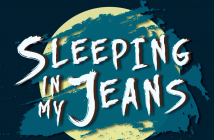Recently, someone asked me how long I’d had an eating disorder. I honestly didn’t know how to answer the question.
“I don’t know,” I said. “It’s not like I knew the last time I threw up was going to be the last time.”
He asked for a rough guess, and finally I said, “I guess, on and off from when I was seventeen till I was twenty-four?”
That answer seemed to satisfy my friend, but it didn’t quite sit right with me. I wasn’t lying, but I didn’t feel like I told the exact truth, either. After all, I didn’t know exactly when my body obsession had turned into an “official” eating disorder, so how can I say when it started? Maybe not until I started making myself throw up when I was eighteen—but then again, after that I went months without doing it at all.
In fact, maybe it never was an eating disorder at all. Maybe I was just really obsessed with food and my body, but never so much that it developed into what I considered a “real” eating disorder, the kind that requires professional help. I didn’t even get all that thin when this was going on. And I never went to a doctor or therapist to discuss it.
This is what I know for sure:
1: Around the beginning of my senior year of high school, I started dieting. I’d gained some weight over the summer and I wanted to lose it. I set myself strict rules (only one “real” meal a day was acceptable), and counted calories.
2: I started carrying water around with me everywhere, chugging it so that I would feel full. When the school nurse expressed a bit of concern I told her that I was just “flushing out my body.”
3: A few months into my freshman year of college, I begged a friend in my dorm to teach me how to make myself throw up. I’d tried before that, but without any success. She walked me through it, and I vomited the entire contents of our dorm’s pre-Thanksgiving Thanksgiving dinner.
4: But I didn’t throw up for months after that; I went back to dieting.
5: Then I gained the dreaded Freshman Fifteen, so I started throwing up more regularly. This went on for years.
6: I stopped throwing up sometime in my twenties. I honestly don’t remember the last time—I just didn’t do it again after that, whenever it was.
I never sought treatment for my eating disorder and my family and friends never seemed troubled by my weight fluctuations. (Once during this period, my mother looked me up and down and said: “The last thing you are is anorexic.” She had always been thin, and couldn’t relate to my struggles with weight. Like me, she assumed that people with eating disorders were painfully thin, their illness easily identified by their protruding collarbones and knobby knuckles.)
My college roommates knew I threw up, but treated it as more of a nuisance than anything else. (I’d overhear them as I crouched by the toilet: “Where’s Alyssa?” “In the bathroom, again.”) They knew I didn’t want to talk about it. I just wanted to lose weight. If they had asked, I would’ve said that therapy couldn’t help me because a therapist would think that the problem was my disordered eating—but I knew the real problem was that I needed to lose weight. A therapist wouldn’t understand, therefore therapy didn’t apply to me.
Today, I know I’m luckier than a lot of people. Somehow, I managed to come out the other side of my body obsession with a healthy relationship with food and with my body. But I still don’t want to talk about it—I’m still not sure that I deserve to.
I thought a lot about whether or not we feel that we deserve to talk about our problems while I wrote my new book, R.I.P. Eliza Hart. In this story, the main character, Ellie, suffers from claustrophobia, and she’s been going to therapy for most of her life. Still, she’s ashamed of her phobia. Her brother mocks her for always needing special help; her classmates torment her. When she starts a new school at the beginning of her junior year, she resolves to keep her problem a secret from her new classmates, and tells her parents that she’s done with therapy.
Unlike Ellie, I’m the sort of person who takes comfort in small spaces, so I did a lot of research on claustrophobia to make sure I got it right. But wanting to take care of your problems yourself—without therapy—and being ashamed that you have a problem to begin with? I didn’t need to do research to relate to that.
I used to look at my friends with such envy—why couldn’t I just be more like them? They didn’t crash diet and binge and purge. They didn’t have to keep track of every calorie they ingested. They only threw up when they were sick. (Then again—I was sick, even if I didn’t think of it that way at the time.)
But, of course, I had no idea what was going on with those girls behind the scenes, just as Ellie has no idea what’s going on behind the scenes with the classmate she admires, the most popular girl on campus, Eliza Hart. It isn’t until Eliza is found dead on the cliffs outside her dormitory that Ellie begins to wonder whether Eliza’s life wasn’t as perfect as Ellie always assumed it was.
My own refusal to ask for help stayed on my mind while I wrote about Eliza and Ellie. With Ellie, I wanted to write a character who would eventually see asking for help as a sign of strength, rather than weakness. With Eliza, whether I meant to or not, I found myself writing about the dangers that come when you refuse the help that’s offered—when you decide it cannot help you, it doesn’t apply to you.
 Even now, it’s hard for me to talk or write about the years I spent living with my body obsession. I’m still not sure I deserve to say that I had a problem at all. It’s difficult for me to write this essay because—like Ellie—I worry that people will look at me or think of me differently if they know I had this problem. But I don’t keep it a secret because, like Ellie, I know that secrets and shame can make troubles worse, not better.
Even now, it’s hard for me to talk or write about the years I spent living with my body obsession. I’m still not sure I deserve to say that I had a problem at all. It’s difficult for me to write this essay because—like Ellie—I worry that people will look at me or think of me differently if they know I had this problem. But I don’t keep it a secret because, like Ellie, I know that secrets and shame can make troubles worse, not better.
It’s funny, now that I think about it—just a few paragraphs ago, I referred to myself as lucky, because I came out the other end of my body obsession healthy and happy. And I am lucky—but as I type this, it occurs to me that I’m not as lucky as I might have been. Perhaps if I had had the strength I wrote for Ellie’s character, I might have gotten this healthy and happy—and this lucky—years sooner.




